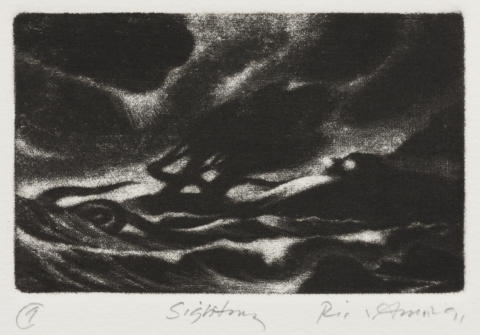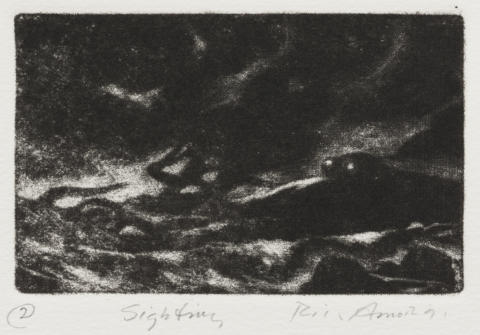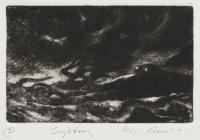
The car’s headlights now appear, illuminating the contour of the hill. The waves in the foreground are more distinct, as are the irregular horizon, the squid’s raised tentacle, and the windswept tree. The impression appears dry, especially in the lower left area.
The squid’s raised tentacle and the area immediately below have been further burnished to make the tentacle stand out with greater clarity.
- Catalogue Number
- E.041
- Title and Date
- The sighting 1991
- Description of Featured Image
- A night-time scene of a stormy sea with a promontory at right, on which stands a windswept tree. To the right of the tree is a car, its headlights illuminating the sea and the giant squid that emerges, writhing, at the left.
- Where Made
- Dunmoochin, Cottles Bridge
- Medium Category and Technique
- Intaglio Print: Mezzotint on copper
- Support
- Wove paper. Identified papers: Arches paper with watermark: ‘ARCHES / FRANCE’ with infinity symbol.
- Dimensions
-
Image size: 65 x 105 mm
Matrix size: 70 x 108 mm - Artist’s Record Number
- RAE.37
- Printer(s) and Workshop(s)
- All impressions printed by Rick Amor in his Dunmoochin studio, Cottles Bridge.
- Summary Edition Information
- Nine states. Nominal edition of ten, but only six impressions printed and numbered, 1991.
- Exhibitions
- Niagara Galleries & NETS Victoria 1993–94: Niagara Galleries & NETS Victoria, Melbourne, Rick Amor & the Graphic Arts, Victorian and Tasmanian tour, 1993–94, no. 42, as Sighting.
- Niagara Galleries at IWOP 1997: Niagara Galleries at the International Works on Paper Fair, Mitchell Galleries, State Library of New South Wales, Sydney, 17–20 July 1997, no. 26.
- Heide MoMA 2008: Heide Museum of Modern Art, Bulleen (Melbourne), Rick Amor: A Single Mind, 22 March – 13 July 2008, no. 9 (Prints), hand-coloured AP, as The sighting.
- Literature
- For the painting The sighting, 1991–92, see Menzies Fine Art Auctioneers & Valuers, Melbourne sale, 25 June 2015, lot 18. See also http://www.menziesartbrands.com/items/sighting.
- Collections
- State Library of Victoria, Melbourne: nine state impressions, numbered 1 through 9.
- British Museum, London: ed. 2/10 (2006,0730.27).
- National Gallery of Australia, Canberra: ed. 6/10 (2007.72).
- Comment
This mezzotint is based closely on a small oil painting of the same title, dated 1992 and April 1991 (Menzies 2015), but is oriented in the reverse direction. Compositionally, the one significant difference between the two works is in the depiction of the squid, whose tentacles remain coiled in the painting but have begun to unfurl in the print. The entire scene is imagined.
The giant squid first appeared in Amor’s prints in 1989, initially in The sea (with giant squid) (cat. no. E.012) and then in The sea (cat. no. E.015). Both of these etchings have a mythic, timeless quality, since they contain no details that might anchor them in an identifiable moment in time. By contrast, in The sighting, the mythic scene is disturbed by the intrusion of the car, and with it a modern, albeit unfathomable, narrative; hence the strange, unsettling nature of the image.
The nocturnal subject matter of E.041 is perfectly matched to the mezzotint technique. Amor took this print through nine states, adjusting the plate in small increments with the burnisher, in order to elicit the precise tones and effects of light that he wanted.
Although all the state impressions are inscribed with the title ‘Sighting’, the edition impressions are inscribed ‘The Sighting’, and this latter title has therefore been accepted as the correct title for the work.
- Keywords
- Car, Sea, Squid, Stormy sea
- URL
- https://catalogue.rickamor.com.au/works/intaglio/the-sighting/
Record last updated 15/02/2021


